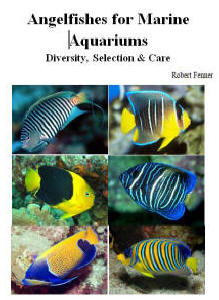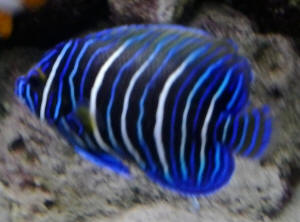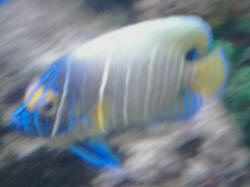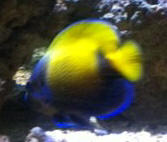|
FAQs about Subgenus Euxiphipops Angelfish
Behavior
Related Articles: Euxiphipops,
Marine
Angelfishes,
Related FAQs: Euxiphipops
Angels 1, Euxiphipops Angels
2, Euxiphipops Angel
Identification, Euxiphipops
Angel Compatibility, Euxiphipops
Angel Selection, Euxiphipops
Angel Systems, Euxiphipops Angel
Feeding, Euxiphipops Angel
Disease, Euxiphipops Angel
Reproduction, Marine
Angelfishes In General, Selection,
Behavior,
Compatibility, Health,
Feeding,
Disease,
|
MD.jpg)
|
Angelfishes for Marine Aquariums
Diversity, Selection & Care
New eBook on Amazon: Available here
New Print Book on Create Space: Available
here
by Robert (Bob) Fenner |
 |
|
Changing Blueface Angelfish. 4/13/13
Hi Crew, I thought I would share these photos with your readers as I
think many people like to see angels change colour. My Blueface
Angel (I was told from the Bali area) about 10cms long - the first
picture taken on the 5th March 2013 and the second today 13th April 2013
In under six week I would say the Angel is now about 70% adult colours I
was incorrect in my previous post as I thought I had the fish for longer
but the date on my camera is more accurate. The tank is a FOWLR, natural
seawater taken from the Andaman sea. I run a chiller set at 30C and a UV
which turns over the tank about once every 15 min.s. I have not had any
problems with disease, except this fish (only one in the tank) did have
Lymphocystis which never goes away but has completely cleared of
symptoms I think because of abrasions when purchased. I feed New Life
Spectrum/Spectrumax 1mm sinking,
<I'd start using a larger grade>
Ocean Nutrition Formula Two pellets and Ocean Nutrition Spirulina
flakes.
The fish is fed three to four times a day and all food is eaten within
30 seconds. Although local natural seafood is available I feel it is
easy to pollute the tank with cockles etc and with these packaged foods
100% is ingested. All my fish colours (except Cubicus box) are great
including my Yellow Belly Regal Tang which are notorious for losing
their colour but mine after 9 months is as blue as when he came out of
the sea. Regards, Adam.
<And our coverage, images can be found here:
http://www.wetwebmedia.com/marine/fishes/angels/pomacanthus/euxiphipops.htm
|

 Re: Changing Blueface Angelfish.
– 04/14/13
Will the pictures go onto your site Bob?
<Already have... search and see. B>
Re: Changing Blueface Angelfish. 4/14/13
Hi Bob, I did search before my earlier email and I have tried again but
still cannot find?
<Search should (does for me) come up w/ the common name or the subgenus
Euxiphipops... and, and...
read all through here otherwise:
http://www.wetwebmedia.com/FishInd3.htm>
I thought this article would help with your readers expectations of colour
change timing I appreciate the Euxiphipops change faster than the
Pomacanthus. I want to try next with a Majestic but the Juveniles seems
like gold dust. Even before in the UK they were extremely hard to get, I
presume because of their relatively high cost and "look the same" factor
as Koran etc. I should not really say this but I took the risk as a
Juvenile coloured Blueface I thought I would get away with putting
him/her in with an Adult Majestic, the Majestic was a little angry at
first but after a couple of days no problems and even with the change to
adult colours of the Blueface seems fine. I have seen photos online that
these two can create a hybrid which I think is because of mass spawning
of both species in a small area as I cannot see "a Blueface and a
Majestic being a pair? Any ideas?
Regards, Adam.
<Have never encountered such a cross. B>
Re: Changing Blueface Angelfish. Note: to do in bold
4/14/13
Thanks Bob I found the article but the pictures are not loading in
Internet Explorer or Firefox.
<Yikes... thank you for this. I took a look. Your pix had + signs in
their namings... I'll have to go back, take out the plus signs
and re-post. B>
add to Euxiphipops beh. f' 4/16/13
Thanks Bob the pictures are loading in both browsers now. Regards, Adam.
<Ah yes; after your notice, I fixed ayer... and tested. B>
Blueface Angel. beh. 6/3/13
Hi,
My Blueface Angel changed in about two months from Juvenile to Adult
colours but now seems in the last month to have slowed right down.
He/she is about 90% Adult, will the fish complete change, is this normal
for the last 10% to be very slow.
Regards,
Adam.
<Happens. B>
|
|
Navarchus losing color
10/3/11
Hey there folks - I have not been able to find a reference to
this particular problem anywhere and was hoping you could
help.
<Will try>
I have had a Navarchus angel for about 18 mo.s now in a 150 gal
Fowlr. He acts and eats very well and has grown from about
3.5" to close to 5" in that time. However for at least
the past year he has been steadily losing iridescent blue color
in a particular pattern. It first disappeared on the margin of
the tail fin, then began fading on the outline of the dark blue
saddle just forward of the caudal peduncle. It is now completely
gone from those two locations and is fading on the rearward
margin of the dark blue area behind the head. In the other
locations - the margins of the dorsal, anal, and pelvic fins, and
the front of the head - it still seems normal. I have attached a
pic for reference.
<See this>
He eats primarily NLS pellets - both Thera-A and color enhancing
varieties, as well as various Ocean Nutrition flakes, some
frozen, gels, and Nori.
Water salinity is on the low side at 1.021,
<Too low... a contributor here. Raise this to natural seawater
strength>
nitrate is <1 ppm,
<How is this kept low? I.e., do you employ chemical
filtrants?>
and temp is 79 F. Lighting is on the low side with only 36 watts
of LED for about 8 hrs per day. There is some hair algae on the
sides for browsing although he doesn't show any interest.
Bioload is fairly low with only 3 other fish - a 6"
melanurus wrasse, a 3.5" Lemonpeel angel, and a 2.5"
flame angel. Yeah, I like angels and have found keeping multiples
to be not very difficult if they are introduced gradually. The
Navarchus is the undisputed alpha fish of the tank however and no
one challenges him.
Other than the color problem all seems well. The fish is getting
to the size where he is becoming "majestic" and he is
beautiful regardless, but I would like to know the problem and
reverse it if possible. Thanks for your help.
Mike
<Mmm, well, the foods you use are good, complete, but I'd
mix in a vitamin/HUFA product as well... As to the real, likely
root issue here, it's water quality... Are you aware of RedOx
measure? Please search, read on WWM re... and we'll chat. Bob
Fenner>
|
|

|
|
Re: Navarchus losing color -- 10/07/11
Thanks for your reply Bob.
<Welcome VD>
I am managing the tank more or less like a reef which is where
most of my experience lies. There is about 120 lbs of good porous
live rock in a very open structure, decent water circulation, and
I wet skim with an old Top Fathom 200a. Perhaps a more modern
skimmer design would be more effective, but I am reluctant to put
money into this when the selection is fairly bewildering and
seems faddish.
<Better for you, others to look into, investigate RedOx,
perhaps acquire/use an ozonizer>
The bioload is relatively low. The water change rate is fairly
low at about only 15 gal per month. The nitrate test kit could be
inaccurate and I may take some water to a LFS for corroboration.
Since your reply I am using multiple water changes to bring the
salinity up to a target of 1.023, which doesn't seem that
much different, but in this situation every possible contributor
counts. I understand the concept but I've never employed a
RedOx meter in the past - perhaps this is something I can have
tested at a LFS
<Mmm, yes>
as well. Generally I've relied on keeping nitrates low and
alkalinity reasonably high (my well water/make up water has
naturally high calcium and an alkalinity of 300 ppm) to ensure
decent overall water quality as other parameters seem to fall in
line when this is done. Perhaps this is not enough in this case
and I am just kidding myself here. I will test accordingly and
step up water changes as a matter of principle.
I need to find a food with the vitamin/HUFA component as well. I
feed Cyclop-eeze on occasion but the Navarchus doesn't eat
much because the particles are so small.
<Look into New Life Spectrum pelleted food... completely
nutritious and very palatable>
If I am successful in correcting whatever is causing this
condition is it likely that the color will return?
<It indeed can>
Thanks again.
Mike
<Certainly welcome. BobF>
|
Pomacanthus (Euxiphipops)
Xanthometopon beh. 8/25/06 Hi, < Howdy! > I've had
my Blue-faced Angel for a little over a year. < Great fish! >
When I got him, he was a changeling. Since then, he has changed
into an adult but never completely finished the change . . . no
blue spot on his rear fin and his face isn't quite as
mottled as other adults I've seen. He's been this way for about
4-5 months. In your opinion, will he complete the change or stay
as is? < Undoubtedly, the angel will finish the change, but it takes
time. A healthy specimen with appropriate food and water can live well
over fifteen years! Yours is probably still a pimple-faced teenie
bopper, waiting to reach maturity. > Thanks, < You are very
welcome! RichardB >
Rich Aylward
Angelfishes for Marine Aquariums
Diversity, Selection & Care
New eBook on Amazon: Available here
New Print Book on Create Space: Available
here
by Robert (Bob) Fenner |
 |
|
|

